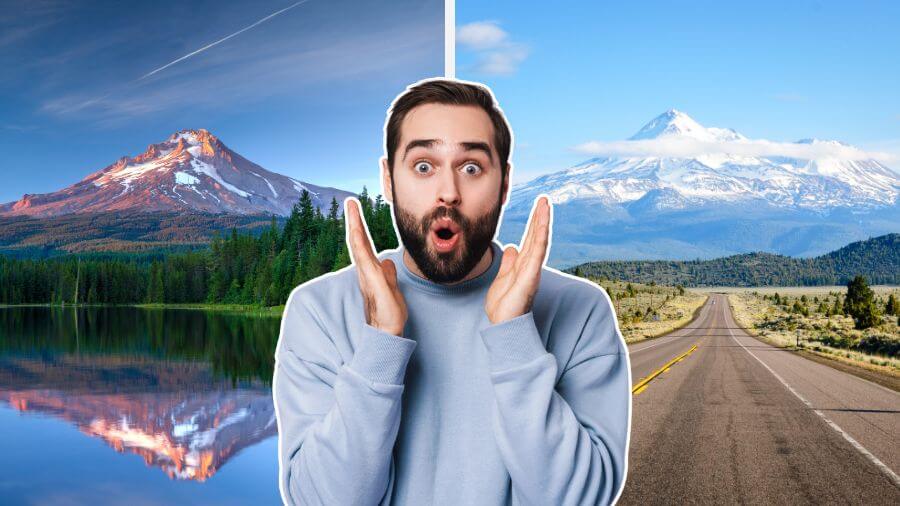There’s something magical about mountains—they’re nature’s skyscrapers, towering above us with their snowy peaks, rugged cliffs and endless views.
Whether you love hiking, skiing or just gazing at their beauty from a distance, the U.S. is home to some of the most breathtaking mountains in the world.
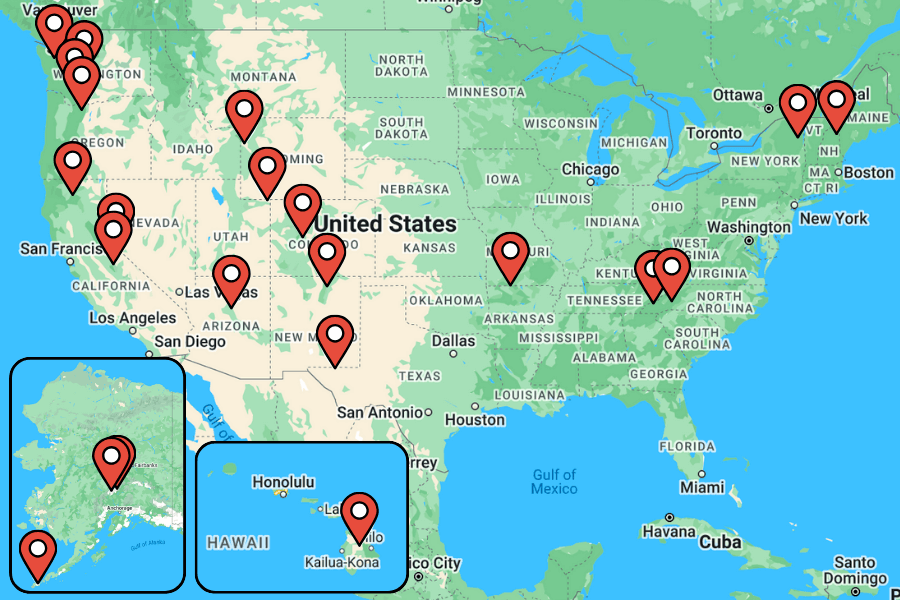
From jagged volcanic peaks to ancient, rolling hills, each range has its own unique charm.
Ready to explore some of the most stunning mountains the U.S. has to offer?
Keep reading to discover the majestic giants that will take your breath away!
1. Denali, Alaska

Denali, the tallest mountain in North America, towers at a whopping 20,310 feet in Alaska’s Denali National Park.
It’s famous for its snow-covered peaks and dramatic, rugged beauty, which draws people from all over the world.

Denali’s two main summits, the South and North peaks, make it an exciting challenge for climbers, but you don’t have to scale it to be wowed—just seeing it from afar is breathtaking!
Fun fact: Denali means “The High One” in the native Koyukon language, and on clear days, you can spot this giant from over 200 miles away!
2. Maroon Bells, Colorado

The Maroon Bells are two stunning, bell-shaped peaks in Colorado’s Elk Mountains, just outside of Aspen.
Known for their dramatic reflections in Maroon Lake, they’re some of the most photographed mountains in the U.S., especially in fall when the surrounding aspens turn a bright gold.

Standing at over 14,000 feet, these mountains are made of distinctive maroon-colored rock, giving them their name and a unique appearance.
Despite their beauty, they’re also called the “Deadly Bells” by climbers because of the dangerous, crumbling rock that makes summiting them extra tricky!
3. Grand Teton, Wyoming
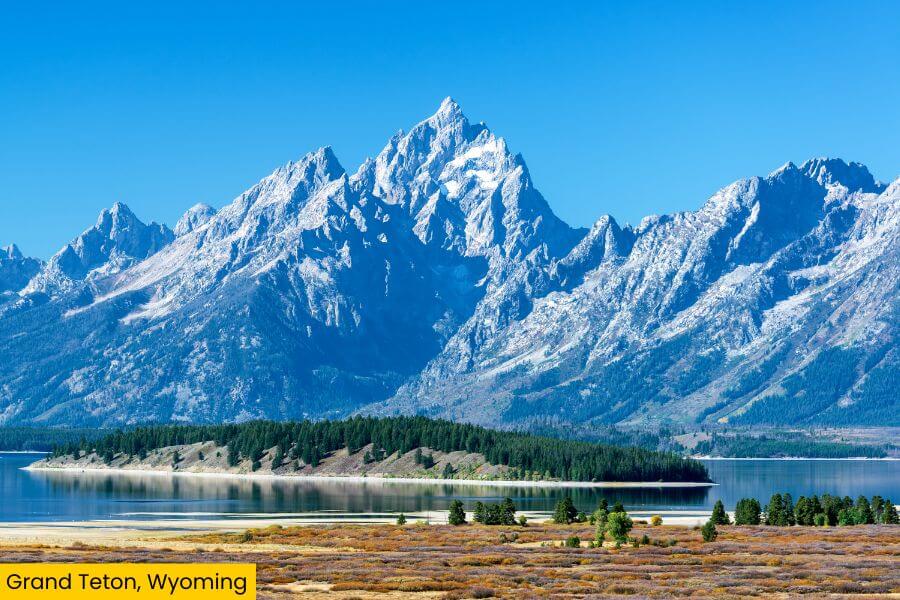
Grand Teton, rising sharply to 13,775 feet, is the star of Wyoming’s Grand Teton National Park and known for its jagged, rugged profile that looks like something from a postcard.
Located just south of Yellowstone, this iconic peak is a favorite with its stunning glaciers, alpine lakes and lush valleys surrounding it.
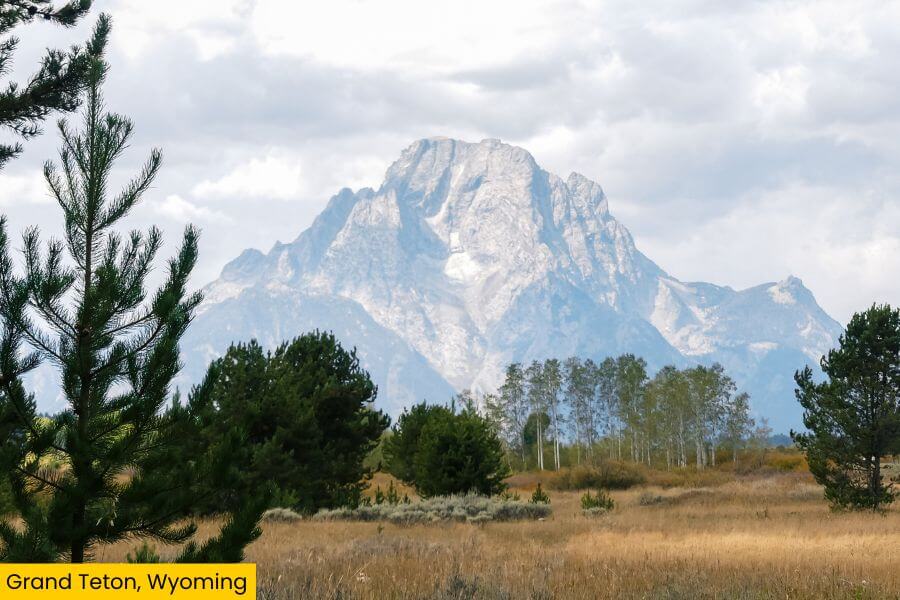
What makes it extra cool? Grand Teton is part of the youngest range in the Rockies, but the rock itself is some of the oldest in the world, over 2.7 billion years old!
On a clear day, you can spot herds of bison and elk roaming the valley below, making for some pretty epic views.
4. Mount Rainier, Washington
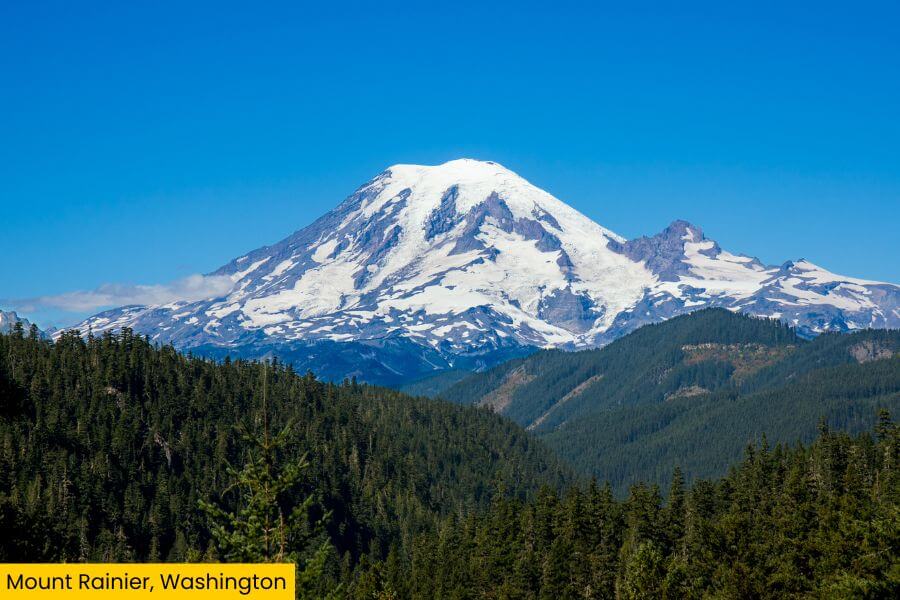
Mount Rainier, towering at 14,411 feet, is an active volcano and the crown jewel of Washington’s Mount Rainier National Park.
Known for its snow-covered peak, wildflower-filled meadows and over 25 glaciers, it’s a favorite for both adventurers and casual hikers.
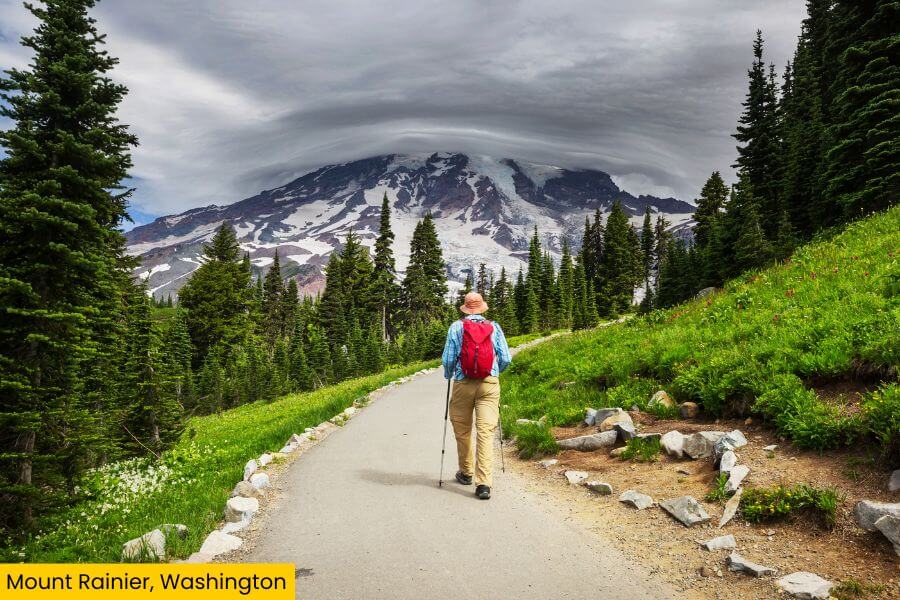
Fun fact: Rainier is one of the snowiest places on Earth, with a record of over 1,000 inches in one winter!
On a clear day, you can even spot this massive mountain from Seattle, standing tall against the skyline like a real-life painting.
5. The Great Smoky Mountains, Tennessee/North Carolina
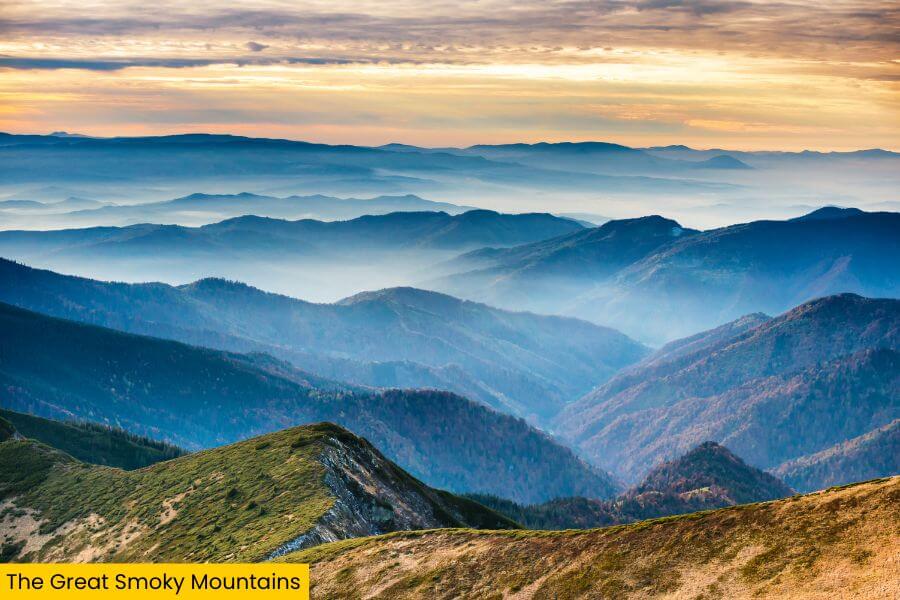
The Great Smoky Mountains, straddling the border of Tennessee and North Carolina, are famous for their misty blue haze that gives them their “smoky” name.
Known for their stunning fall colors, lush forests and diverse wildlife, they’re part of the most visited national park in the U.S.

These ancient mountains, older than the Rockies, are home to hundreds of miles of hiking trails and over 100 species of trees.
The Smokies are also a UNESCO World Heritage Site, and on a lucky day, you might spot a black bear wandering through the woods!
6. Sierra Nevada, California/Nevada

The Sierra Nevada mountain range, stretching across California and Nevada, is known for its dramatic granite peaks, alpine lakes and stunning national parks like Yosemite and Sequoia.
Home to Mount Whitney, the tallest peak in the lower 48 states at 14,505 feet, the range also features famous spots like Lake Tahoe and the giant sequoia trees.

What makes it super cool? It’s where you’ll find El Capitan, one of the toughest rock climbing challenges in the world!
Fun fact: The name “Sierra Nevada” means “snowy mountains” in Spanish, and in winter, the range becomes a playground for skiers and snowboarders.
7. Mount St. Helens, Washington

Mount St. Helens, located in Washington’s Cascade Range, is most famous for its massive 1980 eruption, which blew off the top of the mountain and reshaped the landscape.
Now standing at 8,363 feet, this active volcano is surrounded by forests, lakes and lava fields that make for an otherworldly hiking experience.
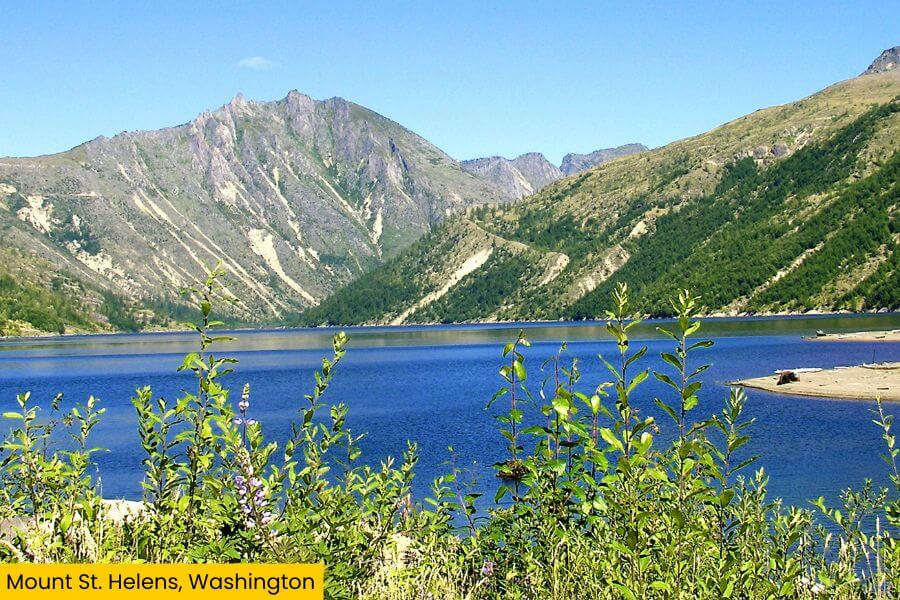
The eruption created a huge crater, and today, you can even hike to the rim for an up-close look at its steaming dome!
The eruption was so powerful that it knocked down enough trees to build 300,000 homes!
8. Mount Shishaldin, Alaska
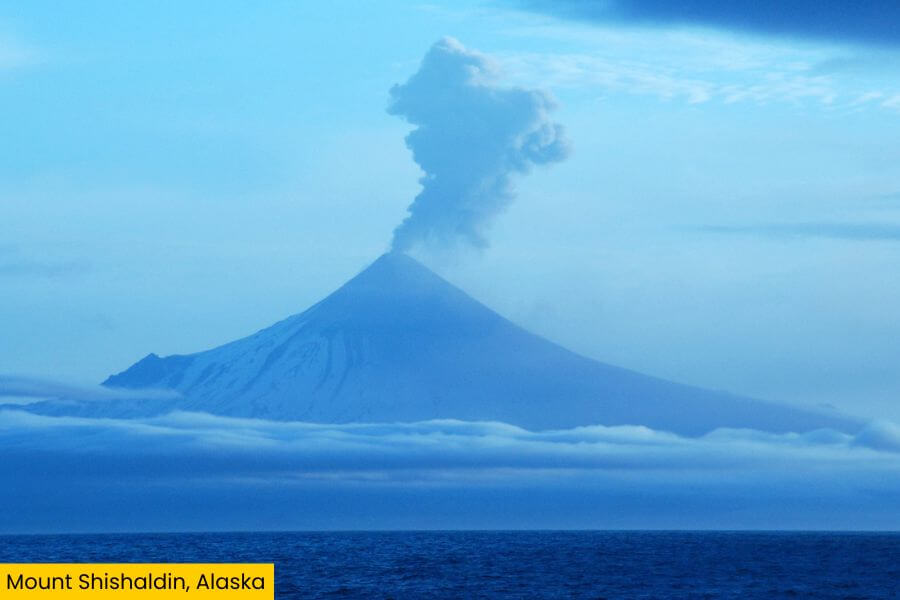
Mount Shishaldin, located on Unimak Island in Alaska, is a nearly perfect cone-shaped volcano and one of the most active in the Aleutian Islands.
Standing 9,373 feet tall, its symmetrical shape makes it look like something straight out of a textbook volcano diagram.

Shishaldin is known for frequently puffing out steam from its summit, and on clear days, you can see it from almost 100 miles away!
Despite its remote location, Mount Shishaldin is the highest peak in the Aleutian Island chain and has been erupting on and off for thousands of years.
9. El Capitan, California

El Capitan is a massive, 3,000-foot vertical rock formation in California’s Yosemite National Park, famous for being one of the toughest climbing challenges in the world.
Made of solid granite, its sheer cliff face attracts rock climbers from around the globe, with the most daring taking on the “Nose” route.
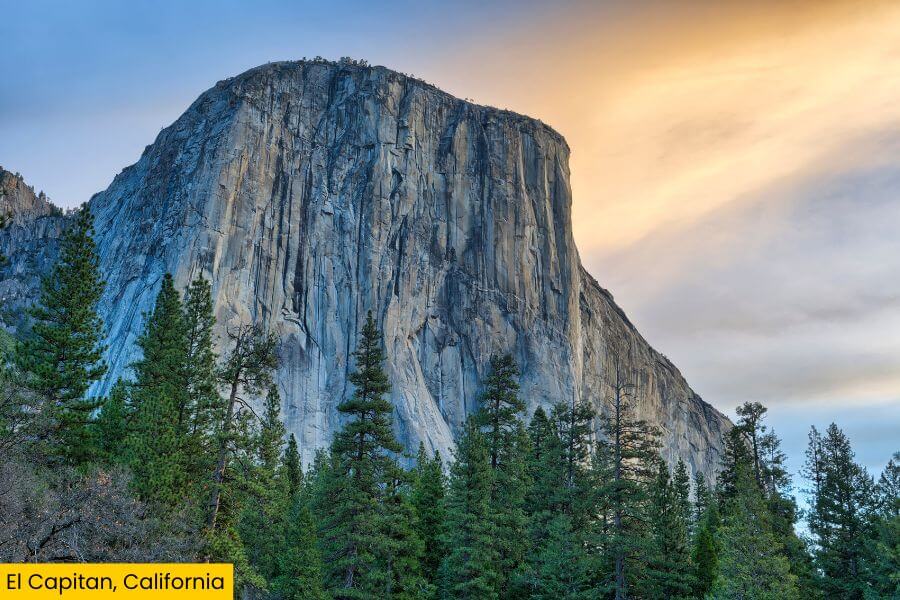
Even if you’re not a climber, just standing at the base and looking up at this giant wall is awe-inspiring!
In 2017, Alex Honnold made history by being the first person to free solo climb El Capitan, scaling it without any ropes or gear!
10. Mount Foraker, Alaska

Mount Foraker, towering at 17,400 feet, is the second-highest peak in Alaska’s Denali National Park, standing just 14 miles southwest of the famous Denali.
Known for its twin summits, the North and South peaks, Foraker offers a striking backdrop to the park’s vast wilderness.

Though often overshadowed by Denali, it’s a challenging climb in its own right, with steep ice walls and unpredictable weather.
Fun fact: Local Athabaskan people call it “Sultana,” meaning “the woman,” as it’s seen as Denali’s partner in the landscape!
11. Guadalupe Mountains, Texas
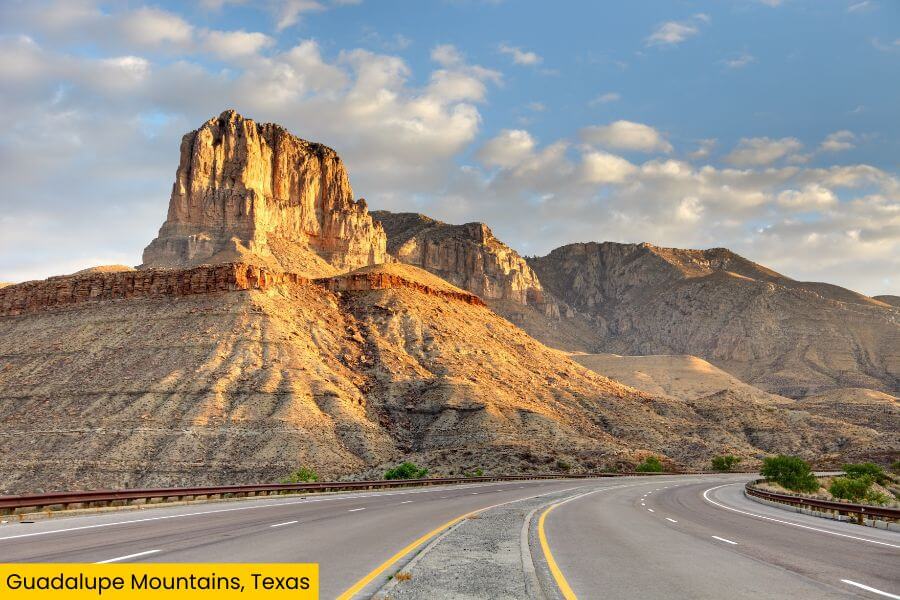
The Guadalupe Mountains are home to the state’s highest peak, Guadalupe Peak, which rises 8,751 feet above the desert.
Known for their rugged beauty, these mountains feature dramatic cliffs, scenic trails and fascinating fossilized reef formations from an ancient sea.
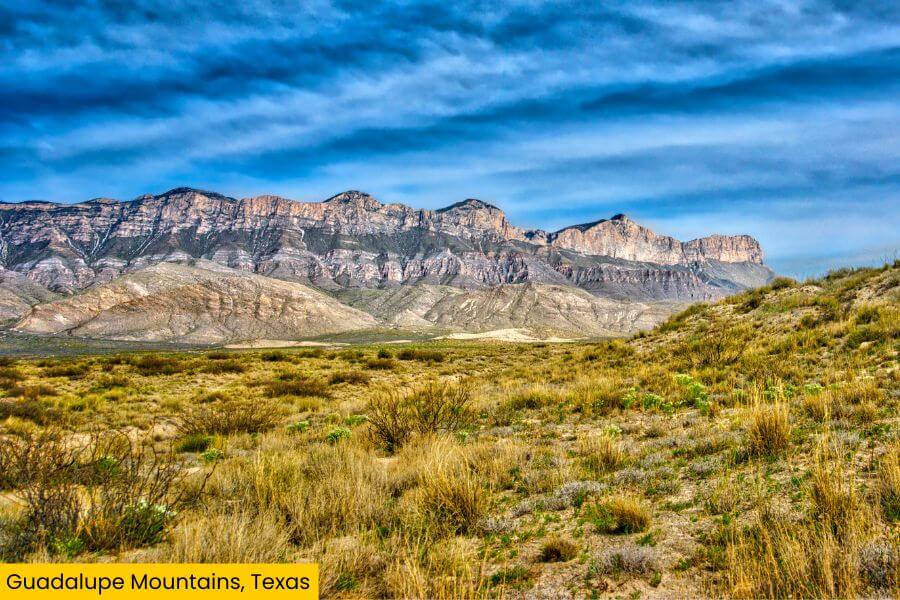
The park is also famous for its diverse wildlife and stunning fall foliage, which is pretty rare in the desert!
Guadalupe Mountains National Park is also one of the best places for stargazing in Texas, with some of the darkest night skies in the country!
12. Ozark Mountains, Arkansas/Missouri
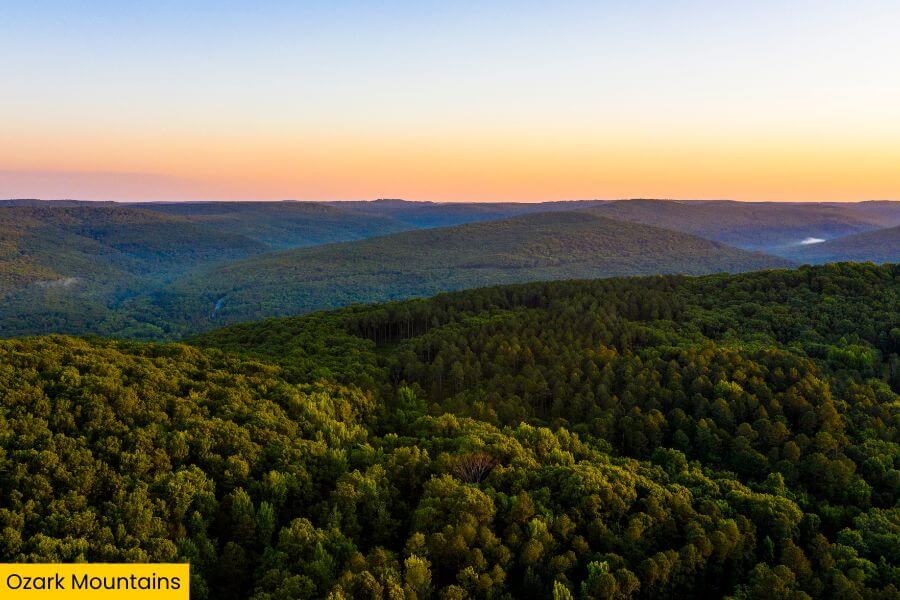
The Ozark Mountains, stretching across Arkansas and Missouri, are known for their rolling hills, dense forests and crystal-clear rivers like the Buffalo National River.
Unlike towering peaks, the Ozarks are a high plateau carved by water over millions of years, which has created beautiful valleys and hidden caves.
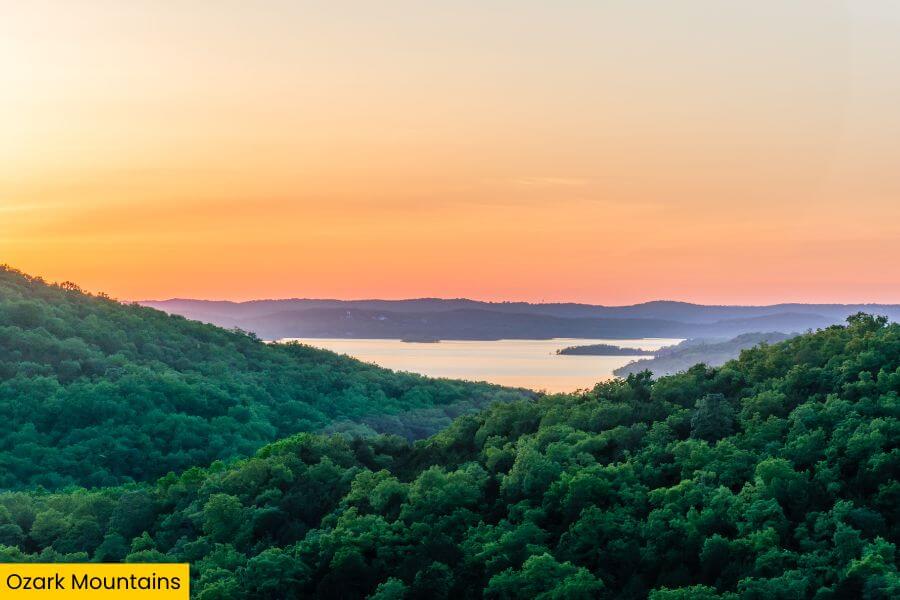
It’s a hotspot for outdoor adventures, from hiking and canoeing to exploring underground caverns like Blanchard Springs Caverns.
The Ozarks are also famous for their stunning fall colors, and the region is one of the best places in the Midwest to catch brilliant autumn foliage!
13. Mount Shasta, California
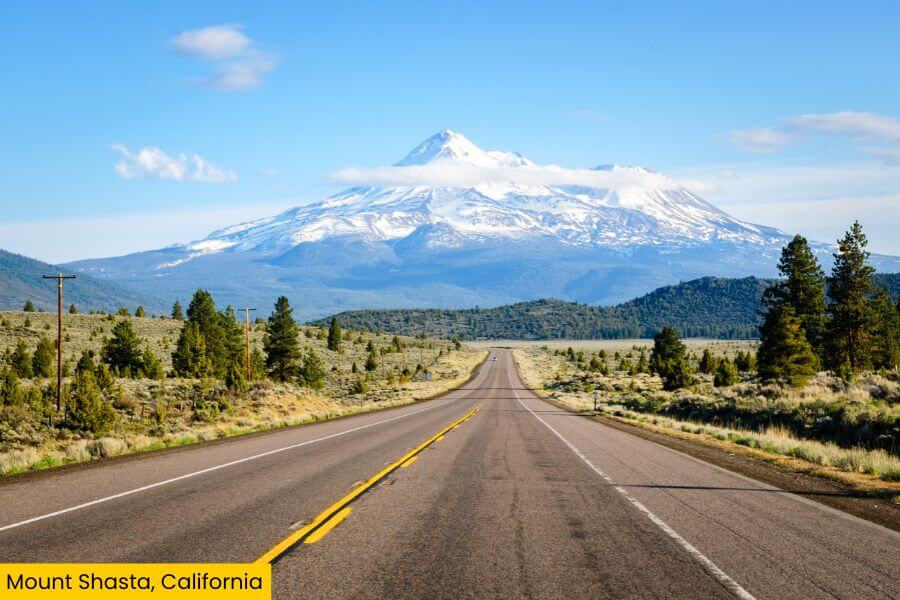
Mount Shasta, a majestic 14,179-foot volcano in Northern California, stands out with its snow-capped peak rising dramatically above the surrounding landscape.
Known for its spiritual significance and breathtaking beauty, it’s a favorite for hikers, climbers and adventurers, with trails that lead through forests, alpine meadows and up to the summit.

Fun fact: Mount Shasta is a dormant volcano, but it’s not extinct—it’s thought that it last erupted in 1786, and scientists keep a close eye on it!
On clear days, this massive peak is visible from over 100 miles away, making it one of California’s most iconic mountains.
14. Blue Ridge Mountains, Eastern U.S.
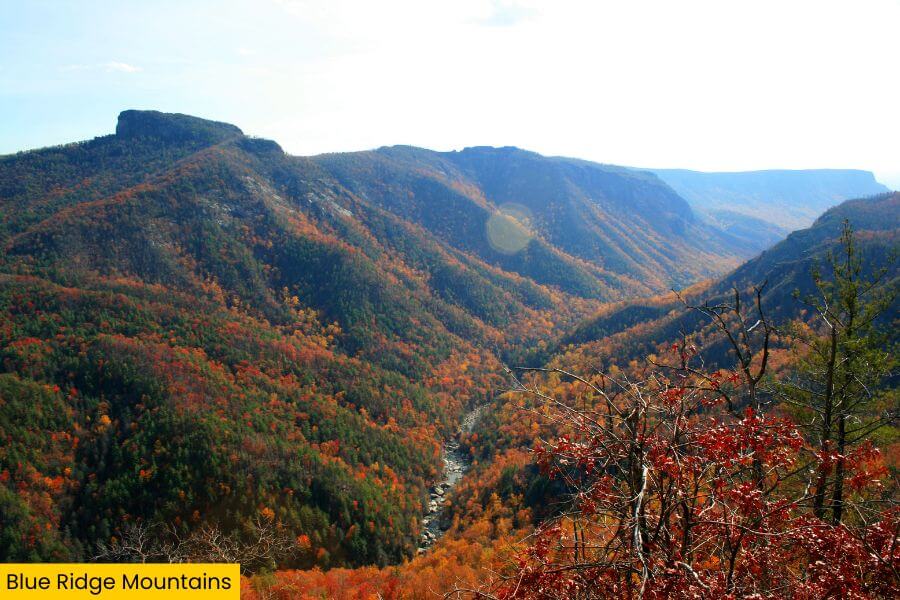
The Blue Ridge Mountains, part of the Appalachian Range, stretch across the eastern U.S., from Georgia to Pennsylvania, and are famous for their soft, rolling hills and signature blue haze.
This misty appearance comes from the trees releasing natural oils into the air, creating that dreamy, blue-tinted view.
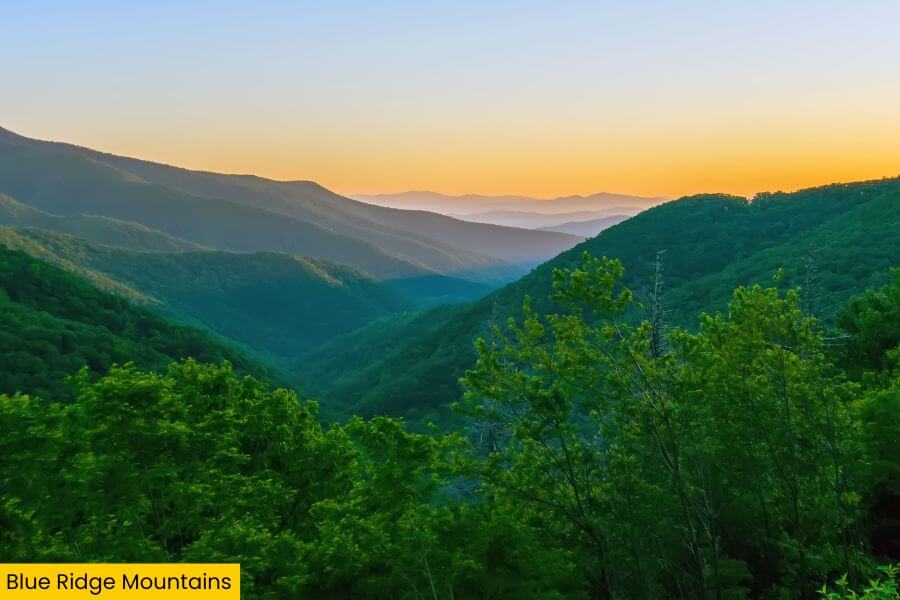
The Blue Ridge Parkway, a scenic drive that winds through the mountains, offers some of the best vistas, especially during the fall when the trees burst into vibrant reds, oranges and yellows.
Fun fact: The Blue Ridge Mountains are home to the highest peak in the eastern U.S., Mount Mitchell, which stands at 6,684 feet!
15. Adirondack Mountains, New York

The Adirondack Mountains in upstate New York are known for their rugged peaks, pristine lakes and endless outdoor adventures.
Unlike most mountain ranges, the Adirondacks are actually a giant dome made of ancient rocks, with over 2,000 miles of hiking trails leading to breathtaking summits like Mount Marcy, the highest peak at 5,344 feet.

These mountains are also famous for their vibrant fall foliage and being a haven for outdoor activities year-round, offering everything from skiing to canoeing.
Fun fact: The Adirondacks are protected as part of a massive state park, which is larger than Yellowstone, Yosemite and the Grand Canyon combined!
16. Uinta Mountains, Utah

The Uinta Mountains in northeastern Utah are unique for being one of the few major mountain ranges in North America that run east to west instead of north to south.
Known for their rugged beauty, they’re home to Utah’s highest peak, Kings Peak, which stands at 13,528 feet and is a popular destination for hikers and backpackers.
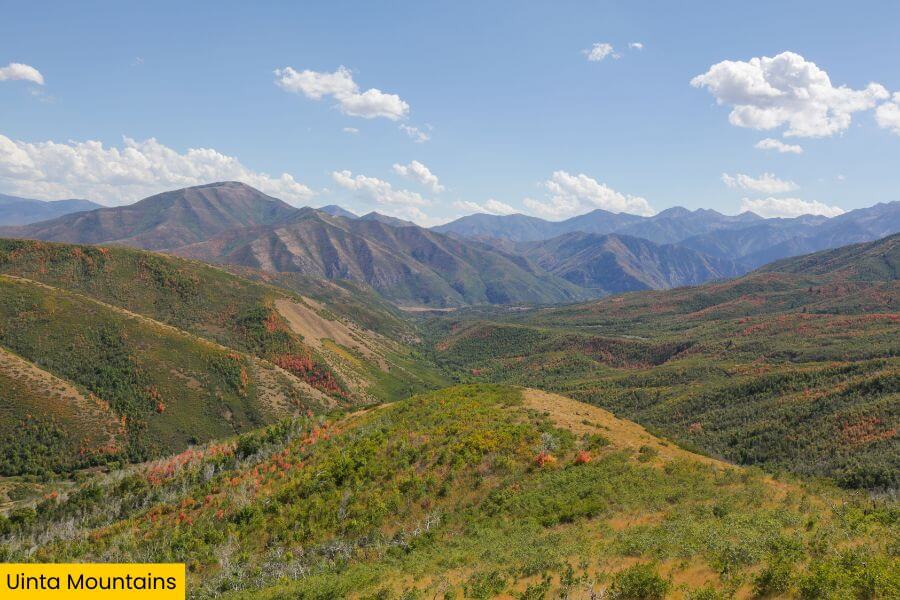
The range is filled with alpine lakes, meadows and stunning ridgelines, offering endless outdoor adventures.
The Uinta Mountains are actually a subrange of the larger Rocky Mountains, and they contain over 1,000 natural lakes, making them a paradise for fishing and camping!
17. Mount Washington, New Hampshire

Mount Washington, standing at 6,288 feet, is the tallest peak in the northeastern U.S. and is famous for having some of the most extreme weather in the world.
Located in New Hampshire’s White Mountains, it’s a popular spot for hikers and adventurers, with the challenging “Tuckerman Ravine” trail being a favorite.

The summit once held the record for the highest wind speed ever recorded on land at 231 mph in 1934!
You can hike, drive or even take the historic cog railway to the top, where you’ll be treated to stunning 360-degree views of the surrounding peaks and valleys.
18. Mount Hood, Oregon

Mount Hood, standing at 11,240 feet, is Oregon’s tallest peak and a beloved icon of the Pacific Northwest.
Known for its year-round skiing on the Palmer Glacier and stunning alpine landscapes, it’s a popular spot for both adventurers and sightseers.

The mountain is also an active volcano, though it hasn’t erupted since the 1800s, and it’s surrounded by lush forests, scenic hiking trails and crystal-clear lakes.
Mount Hood is also home to Timberline Lodge, a historic lodge used as the exterior for the Overlook Hotel in the movie ‘The Shining’!
19. Wheeler Peak, New Mexico

Wheeler Peak, at 13,161 feet, is the highest point in New Mexico and a crown jewel of the Sangre de Cristo Mountains.
Located near Taos, it’s known for its alpine meadows, towering pine forests and sweeping views of the desert below.

Hiking to the summit will give you the chance to spot wildlife like bighorn sheep and marmots, along with breathtaking panoramas of the surrounding landscape.
Wheeler Peak is actually part of the stunning Carson National Forest, and the nearby Taos Ski Valley offers some of the best skiing in the Southwest!
20. Mauna Kea, Hawaii

Mauna Kea, towering at 13,803 feet above sea level, is Hawaii’s tallest peak and actually the tallest mountain in the world when measured from its base on the ocean floor, standing over 33,000 feet!
This dormant volcano is famous for its otherworldly landscape and its world-class astronomical observatories, thanks to its crystal-clear skies.
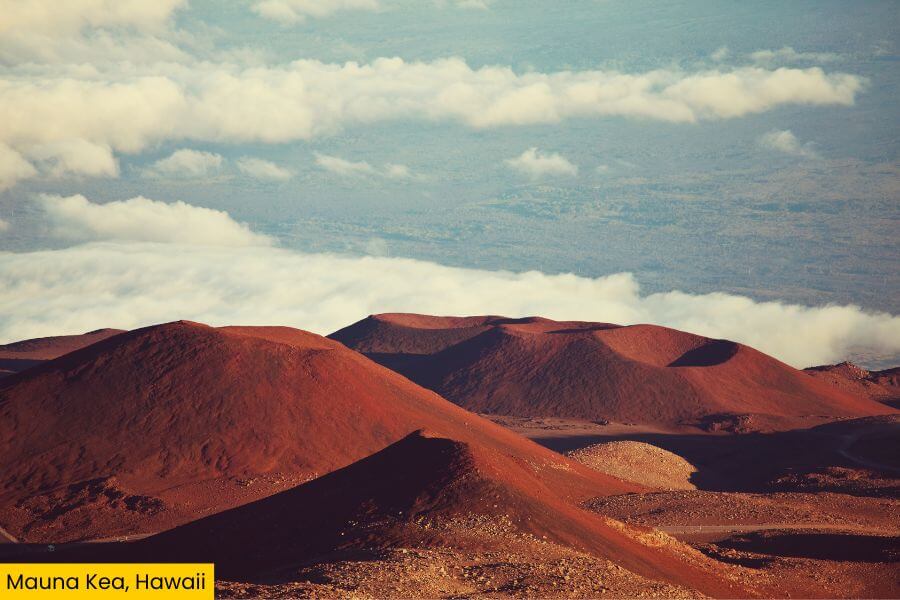
While it’s a sacred site in Hawaiian culture, visitors can hike or drive up to the summit to witness incredible sunset views and stargazing like nowhere else on Earth.
Fun fact: In winter, Mauna Kea even gets snow, letting you experience snow in Hawaii!
21. San Francisco Peaks, Arizona

The San Francisco Peaks, located just north of Flagstaff, Arizona, are the remains of an ancient volcano and include Humphreys Peak, which stands at 12,633 feet making it the highest point in the state.
Known for their lush forests and meadows, these mountains are a popular year-round destination for hiking, skiing and mountain biking.

In the winter, Arizona Snowbowl offers great skiing with stunning views of the desert below.
The San Francisco Peaks are sacred to several Native American tribes, including the Hopi, who believe the mountains are home to their spiritual beings, the Kachinas.
22. Olympic Mountains, Washington
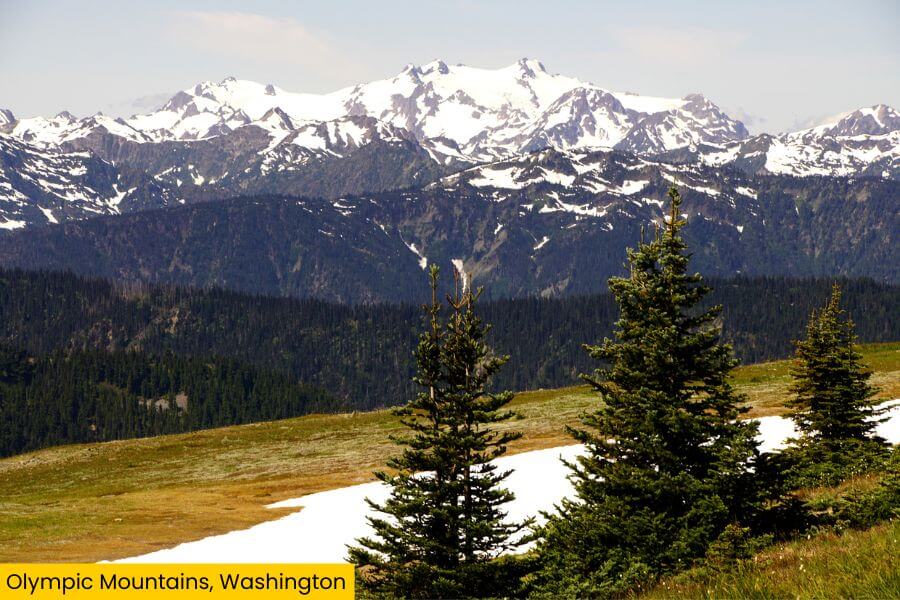
The Olympic Mountains in Washington are known for their rugged, glacier-capped peaks and sit at the heart of Olympic National Park.
These mountains offer an incredible mix of ecosystems, from temperate rainforests to alpine meadows, with Mount Olympus standing as the tallest peak at 7,980 feet.

The range is perfect for hiking, with trails leading to waterfalls, lush valleys and stunning coastal views.
The Olympic Mountains receive an impressive amount of rainfall, with some areas getting up to 12 feet of rain per year, making the Hoh Rainforest one of the wettest places in the U.S.!
Related Posts

